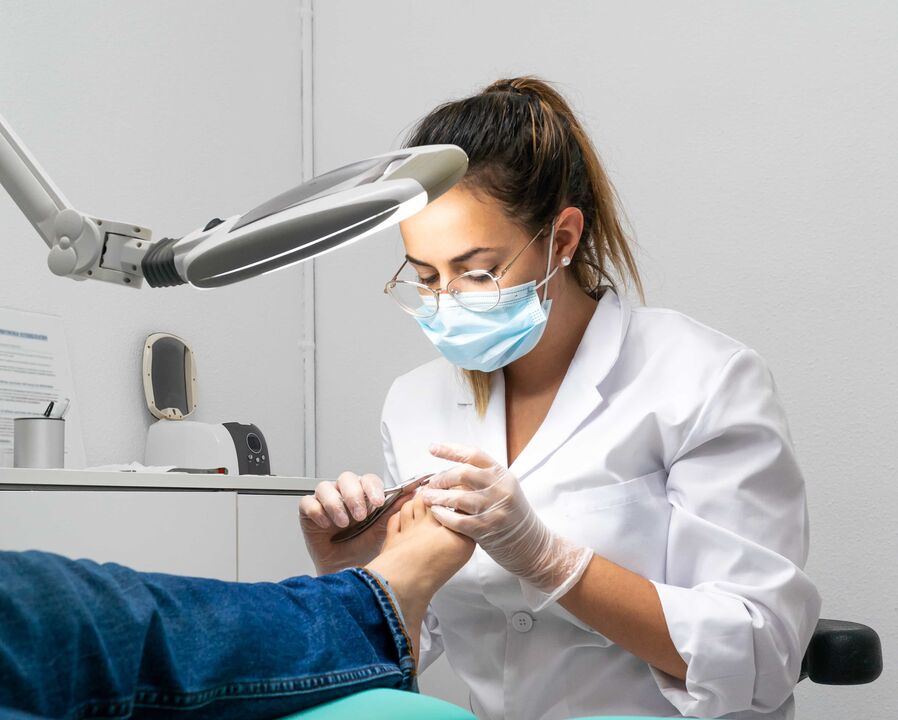
Causes, classification, and pathogenesis of fungal deck infections
- Foot injuries - dermatophytes, Candida albicans, non-dermatophytes molds;
- Nail fungi - dermatophytes, C. parapsilosis, mold preparations.
- Aged over 50 years old;
- Long-term exposure to hazardous work that worsens immune status;
- Frequent sweating of feet due to improper shoe selection;
- Trauma to the nail complex stimulates inflammatory processes and the proliferation of pathogenic microorganisms;
- Immune deficiencies that cause tumors, autoimmune diseases, diabetes, and other diseases;
- Nail plate dystrophy in dermatoses.
Symptoms and pathological stages in adult patients
- Marginal lesions are the first initial stage of pathology and are caused by the entry of external pathogens. Almost imperceptible changes in the nail plate occur in areas of its free part rather than adjacent to the nail bed; yellowish-gray streaks and patterns (areas of nail wear) are noted.
- Normally nourished varieties - the nail plate is damaged in stripes or scallops, but at the same time retains its original thickness and shape; the nails become brittle and appear yellowish-grey; the plates become thinner and grow more slowly.
- Hypertrophic appearance - observed in patients with untreated onychomycosis; thickening of the nail plate at the free part of the nail or the nail fold; they also emphasize complete damage to the plate when the plate uniformly changes color, transparency and thickness.
- White superficial type - more common after long-term treatment with systemic antifungal drugs; white or yellow turbidity appears on the nail surface.
- Distortion of the proximal appearance - the nail plate becomes wavy (similar to a washboard), the color and transparency remain unchanged.
- Onychomycosis of the onychomycosis type - the plates become weak, brittle, thin; occurs on the background of hypertrophic or normotrophic onychomycosis.
- Atrophic type - thinning and brittle nails; occurs when plates are polished frequently.
Manifestations of fungi in childhood
- The normal trophic form of the disease manifests itself as degeneration of plates with normal thickness and shape. Young patients' nails will appear horizontally striated, dull, and whitish-yellow. The bottom area of the board started to peel.
- Fungal leukonychia - looks like pinpoint spots that coalesce over time and cover the entire nail surface.
- Atrophic onycholysis - the nail begins to separate from the nail bed and shortens.
- Distal side mycosis - the appearance of brown transverse grooves (channels formed by pathogens).
Advanced Onychomycosis - What Complications Are Possible?
Which doctor should I see for onychomycosis?

diagnosis method
- General blood tests, urine tests,
- liver enzymes,
- alkaline phosphatase,
- bilirubin,
- Thyroid stimulating hormone.
How does a podiatrist or dermatologist treat onychomycosis?
The most effective treatments for fungus
- ointment,
- cream,
- Varnish.
- Urea.
- Salicylic acid (quinazoline-salicylic acid patch, quinazoline dicarboxamide patch).
- Amorolfine is used twice a week; treatment lasts for six months (hands) and one year (feet).
- The active ingredient is ciclopirox; it is used every other day during the first month, then once a week during the second month of treatment; the course lasts up to six months.
- Clotrimazole in ointment or cream form;
- Bifonazole - cream, spray form;
- Ketoconazole and other medications.























